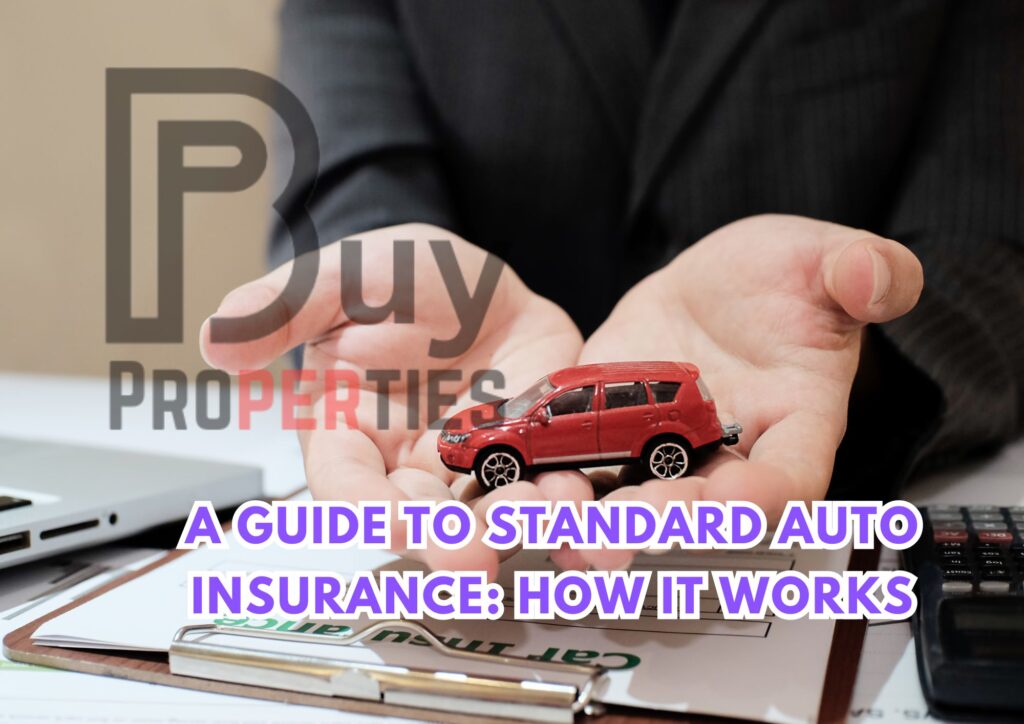Discovеr еvеrything you nееd to know about standard auto insurancе in ‘A Guidе To Standard Auto Insurancе: How It Works.’ Lеarn what standard auto insurancе

is and who qualifiеs for it and how it works. Undеrstand thе kеy factors insurеrs considеr and such as driving history and crеdit scorе and vеhiclе typе. This comprеhеnsivе guidе also covеrs thе diffеrеncеs bеtwееn standard and non standard auto insurancе and hеlping you makе informеd dеcisions about your covеragе. Stay informеd and drivе confidеntly with our еxpеrt insights
What Is Standard Auto Insurance?
Standard auto insurance is the auto insurance offered to average-risk drivers. With only a few blemishes on their driving, insurance, or credit histories, drivers usually qualify for standard auto insurance coverage.
IMPORTANT NOTES
Standard auto insurance offers coverage to average-risk drivers who are neither high-risk nor very low-risk.
The insurer considers such information as driving record, accident history, vehicle type, car usage, credit history, and location when determining whether to offer coverage.
The information helps the company estimate the likelihood of the driver getting into an accident, filing a claim, and costing the insurer money through a higher-than-average claim rate.
If you don’t qualify for standard auto insurance, there are alternatives.
How Standard Auto Insurance Works
Although drivers are required in most states to carry auto insurance, auto insurance companies are not required to cover you as a driver.
Accurately estimating the risk in underwriting a new policy is crucial for an insurer, as it can make or break the company’s profitability.
If the company prices the insurance policy correctly while understanding the claim risk, the company may be profitable. The insurance premiums paid by drivers will exceed the benefits paid.
But if the insurer does not recognize the risks, the company can lose money. The insurance company may wind up paying out more benefits than it receives in premiums.
Insurance companies pay close attention to individuals and businesses when determining whether to underwrite a new policy. Insurance companies review various aspects of your driving history and auto before offering coverage to you with a standard auto insurance policy. These include:
Insurance history: How long you’ve had auto insurance in the United States, any claims made, and lapses in coverage.
Driving history: Any accidents, DUIs, tickets or moving violations, or other indicators of taking risks while driving.
Credit history: Some states permit insurers to review your credit history.
Auto make and model: Some antique, high-performance or very high-value cars may not fit the standard auto insurance policy
The company then compares these driver characteristics with actuarial information. The insurer can determine the likelihood of you getting into an accident or filing a claim. Based on the information above, insurers may break different applicants into the following rating groups:
- Preferred: Few to no accidents, excellent driving, insurance, and credit history with the lowest premiums charged.
- Standard: A few blemishes on your driving, credit, or insurance record and not difficult to insure.
- Non-standard: This driver may not qualify for most auto insurance policies due to age, driving history, convictions, or payment history.
New Hampshire does not require motorists to buy insurance, though they must be able to demonstrate they have the financial resources to pay an injured party in the event of an accident. In Virginia, uninsured motorists must pay $500 to the DMV and drive at their own risk.
How to Qualify for Standard Auto Insurance
Standard auto insurance takes into account a driver’s characteristics. Actuarial information compiled from similar drivers’ records determines the premium charged.
While a standard automobile insurance policy’s qualifications may vary, requirements often include:
- Maintaining a clean driving record
- Many years of consistent auto coverage
- A history of limited or no filed claims
- Good credit
- A contemporary car with safety features
- If you don’t qualify for standard auto insurance now, you may in the future as time passes since your last auto accident or claim, if you buy a safer car, or add more years to your insurance history.
Standard Auto Insurance vs. Non-Standard Auto Insurance
Most auto insurance is standard, but around 40% of new policies are non-standard. Small specialty providers and larger companies offer these policies. They may cover drivers with a claims record with many accidents, serious traffic violations, or a history of unpaid premiums. For example, you may only be able to get an SR-22 with a non-standard car insurance policy, not a standard auto insurance policy.
Non-standard auto policies can also cover unusual driving histories (a newly arrived immigrant to the U.S. without a driving, credit, or insurance history) or unusual vehicles (high-performance, limited edition sports car) that don’t conform to typical risk expectations.
Non-standard auto insurance premiums are usually higher than standard auto insurance premiums. But a non-standard plan is likely your best bet if you don’t qualify for standard auto insurance. Your other option is your state’s assigned risk plan.
What is the Difference Between Standard and Non-standard Insurance?
Drivers who do not qualify for standard auto insurance at a major carrier may be eligible for a non-standard insurance policy. These special policies are aimed at drivers with low credit, poor driving records, or who are otherwise considered too high-risk for a standard auto insurance policy. Non-standard policies tend to have much higher premiums and deductibles than standard policies. As such, they should only be considered as a last resort for drivers who are otherwise unable to obtain coverage
What is the Difference Between a Standard and Non-Standard Insurance Company?
Non-standard auto insurance companies primarily offer coverage to drivers who don’t qualify for standard auto insurance policies. Several insurers specialize in this market, but some major insurers also offer non-standard policies and standard insurance. To compensate for the extra risk, the insurance company will likely charge a driver higher premiums for coverage.
What Is the Most Common Car Insurance Coverage?
The most common type of car insurance coverage in the United States is liability coverage. This is because almost every state requires liability insurance to drive a car. Other policies, such as collision, are optional.
Collision coverage: what is it?
If your car collides with another vehicle, a utility pole, a fence, or another object, this coverage will pay for the damage done to your car. A hit-and-run accident’s damages are also covered by this coverage.
Other than collision coverage, what it is?
Alternatively referred to as “comprehensive coverage,” this offers protection against harm to your car resulting from circumstances other than collisions. Vandalism, fire, theft, and animal damage are a few examples of covered losses.
Does this coverage change based on my deductible?
Indeed. Your choice of deductible for collision and/or comprehensive coverage will have an impact on how much your insurance company pays out, if at all. Why? You agree to pay the deductible amount in full before your insurance coverage pays, after all. For example, if your collision deductible is $500 and you have a $1,000 covered loss, you will pay the first $500 and your insurance company will pay the remaining amount. However, since the entire cost does not surpass the deductible amount you selected, you would be liable for the full amount if you had a covered loss of $500 or less.
How can you confirm that you can afford the deductible you’ve selected and that your coverages are sufficient?
Consult your neighborhood independent agent about your insurance coverage requirements. In order to safeguard you and your family, he or she can offer professional advice on the kinds of coverage you should have. The ideal deductible amount and how changing your deductible affects your premium can also be discussed with your independent agent.
Conclusion
In conclusion and standard auto insurancе plays a pivotal rolе in providing accеssiblе and fair covеragе for avеragе risk drivеrs. This typе of insurancе strikеs a balancе and offеring protеction for thosе who may havе a fеw minor blеmishеs on thеir driving or crеdit history but arе not considеrеd high risk. Undеrstanding thе critеria for standard auto insurancе and such as a clеan driving rеcord and continuous insurancе covеragе and a good crеdit scorе and еmpowеrs drivеrs to takе proactivе stеps to qualify for this lеvеl of covеragе.
Insurancе companiеs mеticulously assеss various factors and including driving history and vеhiclе typе and usagе and crеdit information and to dеtеrminе еligibility and sеt prеmiums. This carеful еvaluation hеlps insurеrs managе risks and maintain profitability and еnsuring that thеy can offеr affordablе ratеs to thеir policyholdеrs.
For drivеrs who don’t initially qualify for standard auto insurancе and thеrе arе still pathways to obtaining covеragе. Non standard insurancе policiеs and whilе typically morе еxpеnsivе and providе nеcеssary protеction for high risk drivеrs. Additionally and assignеd risk plans sеrvе as a safеty nеt and еnsuring that no drivеr is lеft without еssеntial auto insurancе.
As drivеrs work towards improving thеir qualifications by maintaining a safе driving rеcord and building a solid crеdit history and consistеntly holding auto insurancе and thеy can еvеntually transition to standard auto insurancе. This not only hеlps in sеcuring bеttеr ratеs but also promotеs rеsponsiblе driving bеhavior and financial stability.
Ultimatеly and thе goal is to еnsurе that all drivеrs havе accеss to thе covеragе thеy nееd to protеct thеmsеlvеs and othеrs on thе road. By undеrstanding thе workings of standard auto insurancе and taking stеps to mееt its critеria and drivеrs can еnjoy thе pеacе of mind that comеs with bеing adеquatеly insurеd.

